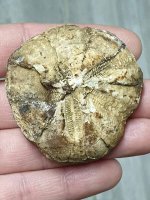Rob1981
Jr. Member
- Nov 16, 2018
- 59
- 160
- Primary Interest:
- All Treasure Hunting
Follow along with the video below to see how to install our site as a web app on your home screen.
Note: This feature may not be available in some browsers.
Holy ****!! Thats amazing!! Thank you for id-ing it [emoji106] the only strange thing is, I've been on many fields but this one field has brought up a few.Looks like gryphaea avcuata, "devil's toenail", an extinct oyster. Your being currently 100 miles from the sea, is interesting, and shows you how the Earth's surface moves around over time. When this oyster died, during the Jurassic, the British Isles were approximately at the same latitude as Lisbon, and under the sea, thus your finding fossilized sea creatures.

Holy ****!! Thats amazing!! Thank you for id-ing it [emoji106] the only strange thing is, I've been on many fields but this one field has brought up a few.
this was the other one we found, someone said it could be a fern fossil? What's your thoughts? View attachment 1655420
Looks like a member of the echinoderm family, a sea urchin who's spines were not preserved. They are not extinct. Other echinoderms present today are sea stars and sand dollars, among others. That one, having been found with your Devil's Toenail, would be of the same age.
Probably, the reason you find them in this one field, erosion over millions of years has eroded the overlying layers, down to the Jurassic-aged limestone layers containing these fossils. The other fields you speak of are likely a higher elevation than this one, and this fossil bearing layer lies deeper underground. If there are any gravel pits, or cut banks in rivers or streams, near there-close to the same elevation-you are likely to find more fossils, if you look around. Being the Jurassic, keep a sharp eye out in that field for anything odd. May find some Dino body parts! Cool finds.
Reminds me of what we refer to as "Sea Biscuits", like sand dollars where the dough has risen. (:
You're so spot on the money m8, there's chalk lines everywhere on the field and sand in the mud in places, if we dig 2- 3 feet down we hit a lime stone/chalk material.[emoji106]Looks like a member of the echinoderm family, a sea urchin who's spines were not preserved. They are not extinct. Other echinoderms present today are sea stars and sand dollars, among others. That one, having been found with your Devil's Toenail, would be of the same age.
Probably, the reason you find them in this one field, erosion over millions of years has eroded the overlying layers, down to the Jurassic-aged limestone layers containing these fossils. The other fields you speak of are likely a higher elevation than this one, and this fossil bearing layer lies deeper underground. If there are any gravel pits, or cut banks in rivers or streams, near there-close to the same elevation-you are likely to find more fossils, if you look around. Being the Jurassic, keep a sharp eye out in that field for anything odd. May find some Dino body parts! Cool finds.
